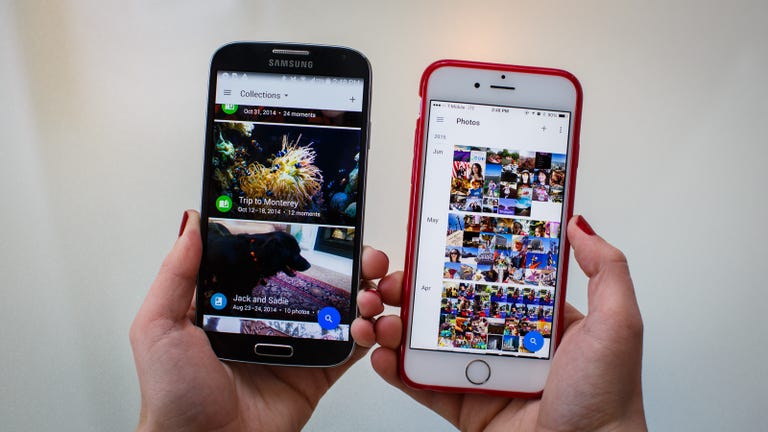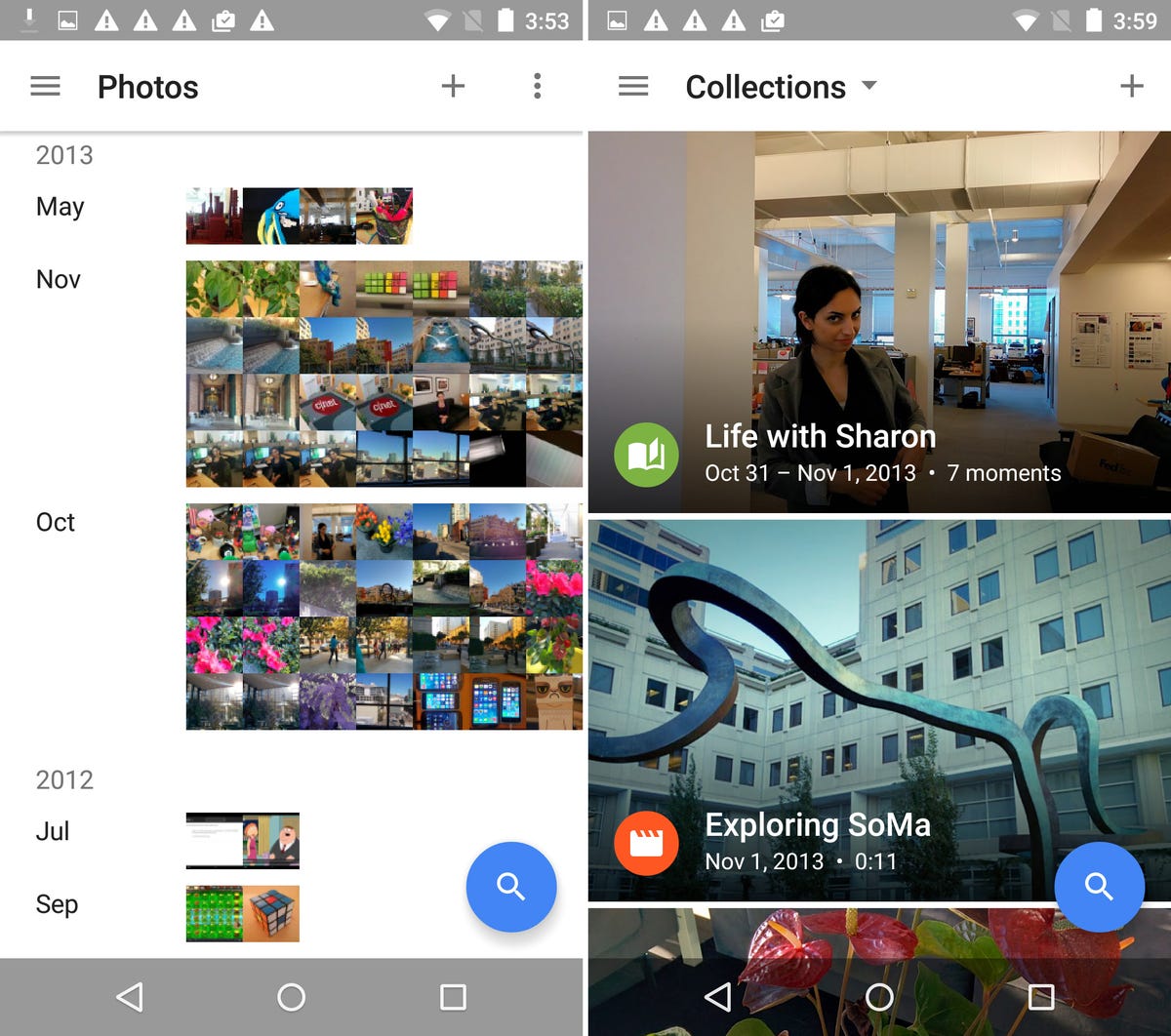 Why You Can Trust CNET
Why You Can Trust CNET Google Photos review: Hands-off photo organization meets eye-catching editing tools
Google Photos takes the best photos from your phone and turns them into captivating albums, GIFs, movies and more, while also backing up everything so you never lose your precious moments.
Google has finally built a straightforward, standalone service that intelligently organizes your entire photo collection. Google Photos, as it's called, has apps for Android and iOS, plus a Web presence, all designed to be your one and only digital photo library.
The Good
The Bad
The Bottom Line
Like its earlier incarnations in Google+, the revamped Photos service stores your photos in the cloud and organizes them into albums automatically. What's changed is that Google is offering free photo storage (some conditions apply) and more tools to make the most of your photos, such as adding custom effects and creating GIFs.
The new Google Photos is a winner, thanks to seamless backups, automatic organization and plenty of tools to make special projects. Though it may lack the free storage space for uncompressed photos that Flickr has or the chance to print out pictures like you can with Shutterfly, Google Photos is a top choice for wrangling your digital photos.
Free service -- with a catch
The biggest selling point of Photos is that it's free with a Google account, but there's a bit of a catch. There are two options for backing up your photos: High-Quality and Original resolution.
The High-Quality option gives you free, unlimited storage, but your photos must be 16 megapixels or less, and video must be 1080p resolution or lower (so no 4K video). Photos and video you upload that are larger than 16 megapixels or 1080p are compressed to that size or lower in order to save space.
With the Original resolution plan, you can backup photos and videos at their full resolution, just as they were when they were recorded, but those files count towards your Google account storage limits. You get 15GB of free storage with a Google account, and that is divided between Gmail, Google Drive and Google Photos. You can purchase additional storage, starting at $2 per month for 100GB.
For most of us taking photos with a smartphone, the High-Quality plan will suffice, since the vast majority of smartphone cameras capture photos smaller than 16 megapixels. You may even be able to get enough of storage out of the Original option too, since 15GB is enough for a few thousand 10-megapixel JPEG photos. Just keep in mind that if you use Google Drive or Gmail, you probably have less than 15GB of free space available.
It's a different story if you're looking to store large raw-format or JPEG photos, such as those taken with a dSLR. Those photos will get compressed with the High Quality option, or quickly max out your space with the free 15GB Original plan, because the files tend to be large. In that case, you'll likely need to pay a monthly fee for extra space in Google Photos or consider opting for competing service Flickr, which gives you 1TB for free. Another option is Amazon Prime Photos, which gives you free, unlimited storage with a Prime subscription.
Back up your pics
With the Google Photos apps, there's an automatic backup feature that saves every photo or video you capture with your phone once you take it. When you first set up the app and turn this on, any existing photos and videos on your device are uploaded to the service.
The Android app lets you choose which photo folders on your phone you want backed up, which is particularly helpful if you don't want your downloads, screenshots or Instagrams saved to Google Photos. Both apps let you decide if you want to upload images over your data plan, or stick with Wi-Fi only.
On the Web at photos.google.com, you can also drag and drop photos and entire folders from your computer to add them to your library. Once synced to your account, photos and videos are accessible everywhere, with the Photos app on your phone or tablet and the website.
Getting around the apps
The new Google Photos apps look nearly identical to the Photos app that's shipped with Android devices for the last several years, but with a closer look you'll see some big differences. Google introduced pinch gestures in order to reduce the seemingly endless amount of scrolling required to navigate through a large library. On the app's main page, images are ordered chronologically by day, but with a few pinches, you can zoom out to see photos grouped by month and year. You can also zoom all the way in on individual photos.
Instead of tediously tapping every individual photo to select it for sharing or deleting, you can tap one photo and drag your finger around to select other pictures en masse. The zoom and selection gestures feel fluid, allowing you to move through the app efficiently.
The app's menu slides out from the left side, where you can jump to your collections and assistant (more on both below), deleted photos, shared links and settings.
The design and navigation is similar on the Google Photos website, but as of this review, the site has several bugs and performance issues. Often times features wouldn't load, and occasionally photos wouldn't upload when selected from my computer. It has many of the same features as the apps, but until it gets more stable, you're better off using Google Photos on your phone or tablet.
Your own photo assistant
Google Photos introduces a brand-new tool called Assistant that serves to help you organize your photos. Like Google Now, the Assistant is a dashboard with cards of useful information. In Photos' case, this is where you can check on the progress of your photo backups and check out photo projects that the app creates for you.
A big draw of Google Photos is Auto-awesome, a tool that automatically enhances certain photos and creates collages, panoramas and even GIFs. It does a great job of sprucing up you photos, either enhancing them with subtle lighting and color changes, or completely overhauling them with a filter. In the Assistant tab, you can see these Auto-awesome projects and save them to your library if you like them, or swipe away the card to discard them. These edits do not change or overwrite your original photos.
Also part of Assistant is a revamped, robust search tool that lets you find photos by typing in a keyword, such as "flowers," "cat" or "baseball." The search tool is really impressive because it's able to seek out colors and other nuanced queries. You can also browse categories that Google has detected from you library, or faces it recognizes through your photos.
Also worth noting here is that sharing has gotten much better in Photos. You can now select the images, albums or Stories you want to share, and Photos will generate a link you can send to others or post on social media. Even better, other people don't need to sign up for or download Google Photos to see what you shared.
Stories, Albums and Collections
A holdover from the previous Google Photos, but now more prominent is the Stories feature, where Google creates curated albums plotted on a timeline of special moments and trips. It does this by grouping photos you take in a new location (based on your photos' geotags), at an event or around holidays, like Halloween and Thanksgiving, and picking out the best images.
When you start using Google Photos, the service will create Stories from your existing library, where appropriate, and then continue to look for opportunities for new ones. The finished result appears in the Collections tab, where you can browse all of your Stories and albums. Stories have a cover photo, title (auto-generated by Google, but editable) and a timeline-like view of your pictures organized by date, time and location. Wherever it can, the app includes maps of where you went and pins of points of interest (like museums or historical sites). Everything is customizable, and you can change the location pins, add photo captions, and swap out pictures or add new ones.
However, there's one missing feature -- you cannot add just any photo from your library to a Story that Google automatically creates. When the app creates a Story for you, it also creates a pool of photos it thinks are associated with that vacation, holiday or event. But sometimes it doesn't include all of the photos that should be in that pool, as was the case for me on a recent vacation. Google Photos grabbed photos from the first three days of my trip, but didn't include images from the fourth day. When I edited the Story, by pressing the plus sign, those photos were missing from the available options.
The remedy for this is to create your own Story by selecting the photos you want in your library, tapping the plus sign and selecting Story from the menu. While it requires a little extra work, you'll get the full control over what's included. You can only create Stories manually in the mobile apps, not on the Google Photos website.
The other way to organize photos is with an album, which simply groups the photos you choose. There are no captions or fancy extras here, just a grid of pictures.
Auto-awesome and other editing tools
Google Photos' Auto-awesome tools automatically enhance your images and create collages, GIFs and panoramas where it can, and it is one of my favorite features of the app. Luckily, you can also use those tools manually create projects at will, which makes it even better. There are some rules to follow, but for the most part, you get complete creative freedom.
Select one or more photos and tap the plus sign to see your Auto-awesome options. If you have between 2 and 20 photos with the same subject, you can create an animation (GIF) that stitches all of them together into a moving image. Another option is to create a movie, which is essentially a slideshow video set to music that you pick. Collages combine several photos into one, but unlike Instagram's Layout, you cannot control the design or move photos around.
Google Photos also includes several editing tools for individual photos, where you can adjust the brightness, change the lighting and color, add vignettes, apply filters, crop and use the auto tool to enhance the picture with one step. Missing however is the ability to edit a photo's metadata, including the date.
Conclusion
After spending a week with Google Photos, I'm hooked. It's one of the best photo-storage apps I've used, especially on a phone or tablet. It's has a more streamlined design than Flickr and has more features for organizing your photos than Apple's iCloud Photos.
I'm particularly drawn to the Auto-awesome features, which intelligently create Stories out of my hundreds of photos and turn mundane photos into engaging collages, GIFs and panoramas. The new Assistant feature lets you know when the app creates a GIF or Story, so you don't miss them.
There's not much bad I can say about Google Photos, except that the website needs work and that the free, unlimited storage option can still be limited for some users. However, it's really only a problem if you need to store photos larger than 16-megapixels, and many smartphone cameras are lower than that resolution.
Give Google Photos a try if you're already in the Google ecosystem and want an easy, often hands-off approach to backing up and organizing your pictures. However, if its sheer amount of features seems overwhelming, try out something simpler, like Amazon Prime Photos. Looking for other options? Check out CNET's guide to the most popular photo storage services.





